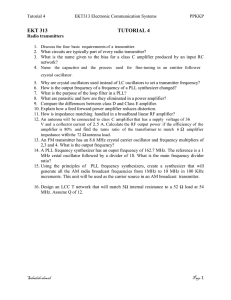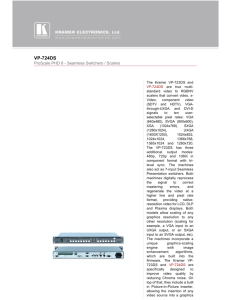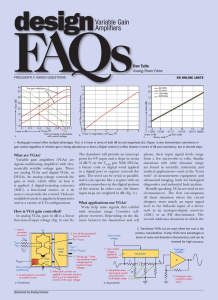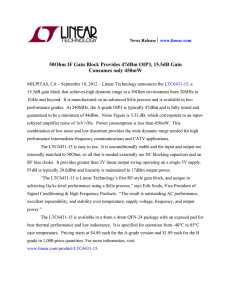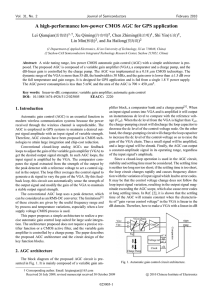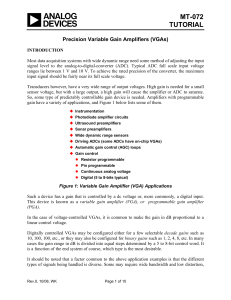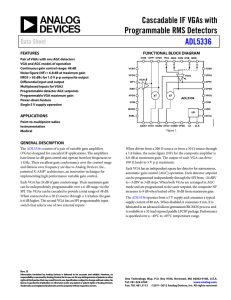Integrated VGA Aids Precise Gain Control DESI
advertisement
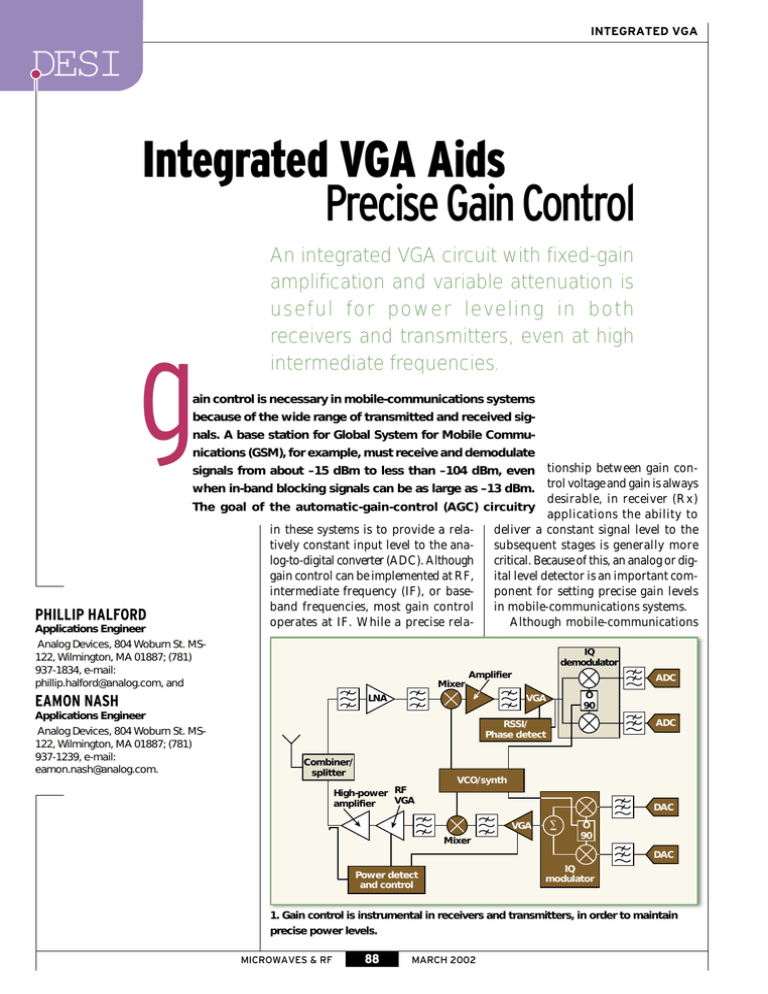
INTEGRATED VGA DESI Integrated VGA Aids Precise Gain Control g An integrated VGA circuit with fixed-gain amplification and variable attenuation is useful for power leveling in both receivers and transmitters, even at high intermediate frequencies. ain control is necessary in mobile-communications systems because of the wide range of transmitted and received signals. A base station for Global System for Mobile Communications (GSM), for example, must receive and demodulate tionship between gain control voltage and gain is always desirable, in receiver (Rx) circuitry applications the ability to deliver a constant signal level to the subsequent stages is generally more critical. Because of this, an analog or digital level detector is an important component for setting precise gain levels in mobile-communications systems. Although mobile-communications signals from about –15 dBm to less than –104 dBm, even when in-band blocking signals can be as large as –13 dBm. The goal of the automatic-gain-control (AGC) PHILLIP HALFORD Applications Engineer Analog Devices, 804 Woburn St. MS122, Wilmington, MA 01887; (781) 937-1834, e-mail: phillip.halford@analog.com, and in these systems is to provide a relatively constant input level to the analog-to-digital converter (ADC). Although gain control can be implemented at RF, intermediate frequency (IF), or baseband frequencies, most gain control operates at IF. While a precise rela- IQ demodulator Amplifier LNA EAMON NASH Applications Engineer Analog Devices, 804 Woburn St. MS122, Wilmington, MA 01887; (781) 937-1239, e-mail: eamon.nash@analog.com. ADC Mixer O 90 VGA ADC RSSI/ Phase detect Combiner/ splitter VCO/synth High-power RF VGA amplifier DAC VGA Mixer O 90 DAC Power detect and control IQ modulator 1. Gain control is instrumental in receivers and transmitters, in order to maintain precise power levels. MICROWAVES & RF 88 MARCH 2002 Mode Gain Integrator Gain interpolator Output buffer VOUT terminals must be able to transmit over a large power range, such as 75 dB in wideband code-division-multiple-access (WCDMA) systems, a large range of power control is also needed in the base station. Network operators must be able to vary cell sizes by fixing the nominal or static base-station power at system installation. In the case of GSM, the nominal base-station power can be adjustable over a Gm Gm 0 dB –5 dB –10 dB INPT Gm Gm –45 dB 200 Attenuator ladder 2. The AD8367 X-AMPTM architecture provides precise linear-in-dB gain control over a wide dynamic range. 12-dB range. If the base station has a fixed-gain power amplifer [PA] (which is generally the case), the nominal output of the base station must be set by varying the input signal to the PA (Fig. 1). In addition, the transmit power will vary depending upon the distance to the mobile unit. Also, time-divisionmultiple-access (TDMA) systems such as GSM and IS-136 require orderly power ramping. This adds another 40 to 50 dB to the power-control range of Although mobile-communications terminals must be able to transmit over a large power range, such as 75 dB in WCDMA systems, a large range of power control is also needed in the base station. the base station. In the case of a CDMA or WCDMA base station, the signal power out must be varied as the call loading in the cell varies. In transmit applications where the output will be constantly varying for any or all of the previously stated reasons, the relationship between the gain of a variable-gain amplifier (VGA) and its gain-control voltage becomes important in the struggle to set the correct power. For example, if the VGA has a gain-control relationship that is linear, temperature-stable, and flat within the band of interest, a simple two-point VGA calibration will be sufficient. Using the calibration data, the base-station controller can confidently set the power ● Enter NO. 433 at www.mwrf.com MICROWAVES & RF 90 MARCH 2002 45 40 2.0 1.6 35 –40ºC 3. Temperature-stable, linear-in-dB gain control allows for precise setting of gain over a wide dynamic range. 25 15 –0.8 5 85ºC 0 0.1 0.2 0.3 0.4 0.5 0.6 VGAIN—V ● Enter NO. 406 at www.mwrf.com 93 –1.2 –1.6 where the output will be constantly varying, the relationship between the gain of the VGA and its gain-control voltage becomes important in the struggle to set the correct power. MICROWAVES & RF 0 –0.4 10 In transmit applications was to meet performance requirements for a variety of cellular base-station systems over a wide range of IFs, even though achieving a temperature-stable, linear-in-dB gain-control range at high frequencies represents a significant challenge. For example, IFs in single-conversion superheterodyne Rxs for cellular base stations can be as high as 380 MHz. One of those integrated VGAs, the model AD8367, integrates a variable atttenuator with a 45-dB range (0-to-45-dB attenuation) with a very linear fixed-gain amplifier (Fig. 2). The AD8367 is based on the company’s patented X-Amp architecture (named after the exponential nature of the gain-control function). The precise linear-in-dB scaling [i.e., (gain (in dB)/(VAGC (in V) is constant] significantly simplifies AGC design in cellu- 0.8 0.4 25ºC 20 –5 0 1.2 MARCH 2002 0.7 0.8 –2.0 0.9 1.0 Error—dB and ignore changes in temperature and frequency. Without such linearity, however, a number of calibration points will be needed across the frequency band of interest. And if the performance varies as a function of temperature, additional calibration points will be needed to account for these temperature-dependent variations of gaincontrol voltage. An AGC circuit typically consists of a variable attenuator followed by fixed-gain amplifiers. By integrating these functions on a single chip, it is possible to develop VGAs with high performance levels while dramatically shrinking the overall size of the circuitry. One development goal for a new generation of VGAs from Analog Devices Gain—dB 30 Noise figure—dB optimally in a 200 system. In addition, the AD8367 has an integrated squarelaw detector for the AGC function. OIP3—dBVrms lar base stations compared to the use of discrete VGAs or PIN-diode attenuators with cascaded gain amplifiers. The main signal path consists of a voltage-controlled 0-to-45-dB attenuator followed by a 42.5-dB fixed-gain amplifier. The AD8367 is designed to operate 60 50 Noise figure 40 OIP3 10 MHz OIP3 70 MHz OIP3 140 MHz 30 20 OIP3 240 MHz 10 0 0 0.1 0.2 0.3 0.4 0.5 0.6 Vgain—V 0.7 0.8 0.9 1.0 4. As gain increases, the AD8367’s noise figure improves while the OIP3 remains fairly constant. In AGC mode, the gain-bias pin provides the received-signal-strength-indication (RSSI) control and the output signal is leveled 354 mV RMS (1 V p-p for an unmodulated sine wave). This circuit is particularly useful if an Rx must handle signals with different modulation formats. A good example of this would be a modern GSM base station that must receive both Gaussian minimum-shiftkeying (GMSK) and eight-state phaseshift-keying (8-PSK) modulation (EDGE) signals. The integration of attenuator followed by fixed-gain amplifier is an ideally suited to Rx AGC circuits, since the input third-order-intercept (IIP3) and the noise figure track dB per dB with the gain setting (Fig. 3). When the input signal is strongest, the gain is at a minimum and the IIP3 and noise figure are at maximum levels. When a received signal is weakest, the gain is at a maximum and the IIP3 and noise figure are optimum for the weak signal, thereby maintaining a wide signal dynamic range. The output third-order-intercept (OIP3) and output power at 1-dB compression are independent of the gain and temperature, which is another significant advantage over discrete VGAs, which can suffer drifting output power levels with temperature and gain settings (Fig. 4). The AD8367 is packaged in a 14lead thin shrunk small outline package (TSSOP) and is characterized for operating temperatures from 40 to +85ºC. It operates on a single voltage supply from +3 to +5 VDC. The integrated device has a 3-dB bandwidth of 500 MHz, and has been thoroughly evaluated at common IFs such as 70, 140, 190, and 240 MHz. Evaluation boards and samples are now available. MRF ● Enter NO. 420 at www.mwrf.com MICROWAVES & RF 94 MARCH 2002

